Reclaiming Time and Place
An Interview with Nikesha Breeze, Miles Tokunow, and MK about Stages of Tectonic Blackness
BY EMMALY WIEDERHOLT
Stages of Tectonic Blackness is a durational dance performance ritual performed by Nikesha Breeze and Miles Tokunow with musical performance by Lazarus Nance Letcher and with cinematographic documentation by MK. It was first performed in September 2020 in the Sandia Mountains outside Albuquerque, NM, and more recently performed in Blackdom, NM in November 2021. Blackdom was a historic homestead incorporated in 1903 by 13 African Americans in southern New Mexico. Over the next decade, it grew to have almost 200 residents and a post office. By 1920, a combination of drought and oil speculation had driven away most of Blackdom’s population. Here, Nikesha, Miles, and MK share the impetus behind creating Stages of Tectonic Blackness, what it meant to perform it first in the Sandia Mountains and then in Blackdom, and how exploring the state of a resting Black body on the earth is a radical act.
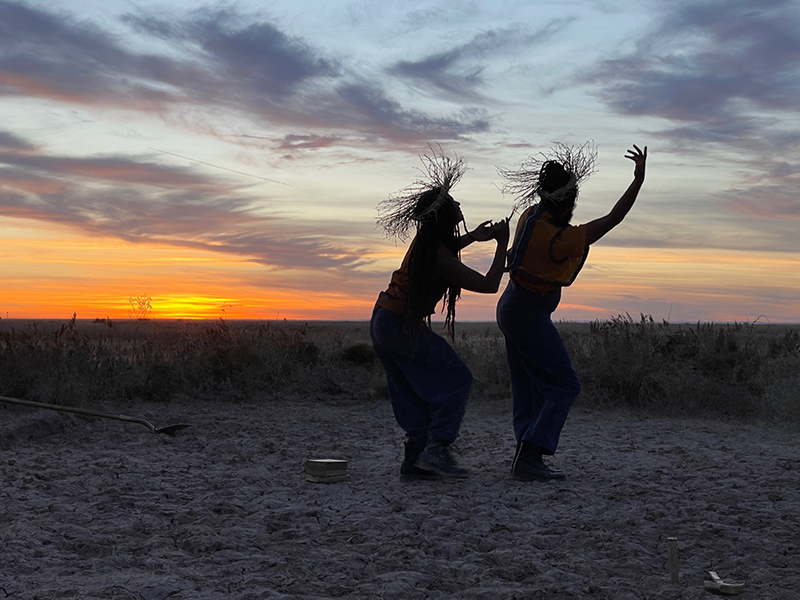
Photo by Noël Hutton
~~
Can you tell me a little about your performance histories and what shaped who you are as artists today?
Nikesha: I’ve been working in performance – theater, dance, film, and performance art – since the 80s. I used to work in Portland, OR, with Northwest Children’s Theater doing dance performance. I moved to avantgarde circus and performance with Wise Fool New Mexico and have done that for almost 15 years. And I’ve also done a lot of street and guerilla performance in Latin America and South America for about four years.
MK: I’m the documenting part of this collective. In terms of documentation and working collaboratively, I’ve been doing it since 2014. I picked up a camera in high school and haven’t put one down since.
Miles: I started dancing in middle school. I’ve always been interested in the ways in which moving our bodies can change how we experience the world. That led me to dancing and learning delicious movement, like butoh in college, and then moving to Santa Fe, NM after college and dancing site specific with a bunch of friends. I try to stay away from the theater as much as possible; I love the ways in which dance on site has magical possibility.
What was the impetus behind Stages of Tectonic Blackness?
Miles: Looking back at spring 2020, I was really disheartened by reactions to the murder of George Floyd. I got a lot of text messages from white friends saying, “Thinking of you, love you.” It made me think about when my life mattered and when it didn’t, and the hyper performativity that happens on social media. My feeling was we need to slow down and we need to go further. That fast-paced social media landscape is exhausting. We need to slow down, rest, and be in communication and in healing relationship with beings in nature that have been here much longer than the construct of race.
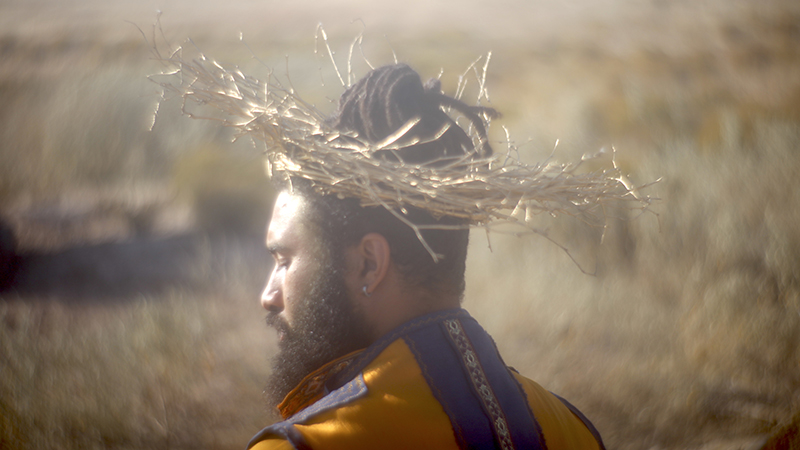
Photo by Monica Kennedy
Nickesha: I met Miles at a workshop I taught in Albuquerque called Decolonizing the Body in 2019. Miles called me up in 2020 and said he had the idea of doing a durational ritual dance performance. Knowing I’d done durational pieces in the past, he wanted to ask me about the process and if I wanted to be involved. That planted a seed.
We had a beautiful conversation about what it meant to decolonize time and be a Black body touching the earth. We talked about the radicality of slow movement for Black bodies in a society that is infatuated with Black death or Black production. The only stillness we’re allowed is in death. How do we transmute that and bring life? What does it mean to be a Black still alive body on the earth? That was a profound point for us.
The desire to gather as Black artists and see what we could do was ripe, and also to break some boundaries: Could we even do this with COVID? We brought in Lazarus for music, and the sound he created was absolutely correct in spirit for this piece. We also brought in MK as a cinematographer and as another Black body holding the same space with us laying on the earth with camera in hand. We talked and shared resources and dreams. It was a non-directed collaborative merging of minds.
What was the process developing the work?
Miles: It was a collaborative process where we brought our full selves into building this performance/pedagogy/way of being. One of the delicious ways of developing movement was we came in with all these theoretical texts and talks about Blackness as it pertains to extraction. We would give each other challenges, sort of like homework, bringing in nuggets in the creation of this ritual and movement language. We had this well of inspiration we made for each other to draw from.
Nikesha: We wanted to perform in the Albuquerque region. We were looking at the relation to Tiwa land and the larger conversation between Indigenous and Black bodies. We also needed a place that was wide enough for people to spread out because of COVID. Landscape-wise, we wanted an area with rock formations. There were several places we envisioned that didn’t have ideal parking, mobility, and accessibility needs. We settled on the Piedra Lisa Trailhead in the Sandia mountains.
All of us are scholars/historians/researchers/nerds/dancers/artists. We really geek out. Deep research isn’t always part of artists’ processes, but we researched how Piedra Lisa was connected to extraction and nuclear radiation. We had a Geiger counter that was incorporated into the soundscape and we “Geigered” the rocks and land. We had all this research to fill the coffer of what movement and consciousness could come through as we participated with the space.
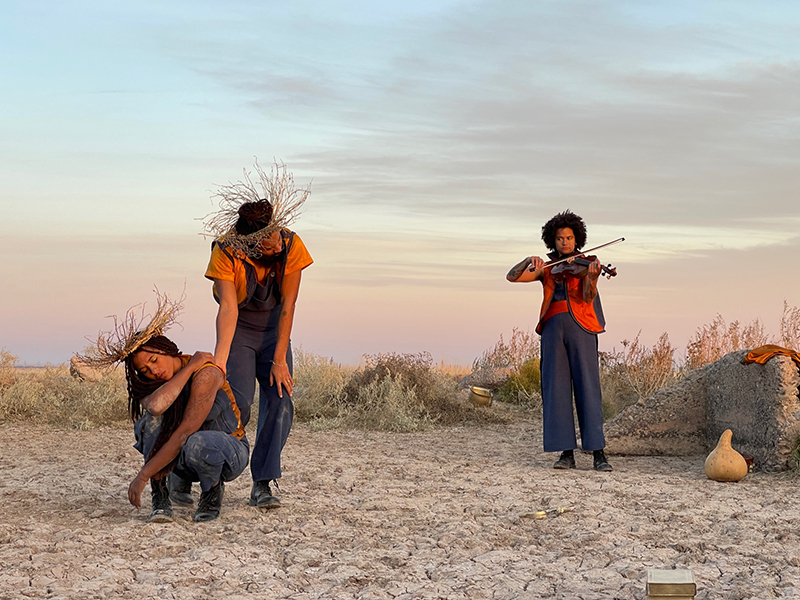
Photo by Noël Hutton
MK: I first met Miles when I moved to Albuquerque in 2017 when I photographed him and his partner. From there, he contacted me to take promo photos for the project. A couple weeks later he asked if I would document Stages.
The day we filmed, I was down to be there for the whole eight hours. I found myself not able to leave, and instead was running back and forth between the performers, wanting to capture every moment. Eight hours is a long time to document anything, especially when using battery power, so I focused on the gestures. It was the first time someone had given me complete autonomy. I used a portrait lens in video mode, and I’ve committed to using it exclusively for the ongoing collaboration.
What was your experience performing Stages of Tectonic Blackness in September 2020 at Piedra Lisa Trailhead outside Albuquerque?
Miles: We had never moved together because of COVID, only in separate spaces online. At Piedra Lisa, it felt like creating a healing portal that was ancestral and futuric and time collapsing/expanding. There were moments being in relation with these rocks that had little bits of radiation that transported me over to Hiroshima where my grandfather’s family is from and where victims of the first atomic bomb died. The performance was an opening to allow for these connections and healing possibilities.
MK: It felt like we were grieving or saying sorry. I remember having a conversation with Nikesha about how we had given our blood because we both had injuries during the performance. It sucked we got injured, but it was part of the ritual in the gentlest way possible. It was a grieving ground for me. It gave me the space to grieve my own things as well as collective grieving. It was strange that the grieving was public. It reminded me of a funeral; it was about the gesture of what we were doing.
It was very scary at the beginning. We were all nervous, though we had nothing to be nervous about in hindsight. In Albuquerque, the mountains are in the East and the volcanoes are in the West, so you see the shadows of the mountain get smaller and smaller. It was this beautiful sense of time passing. The experience really stayed with me.
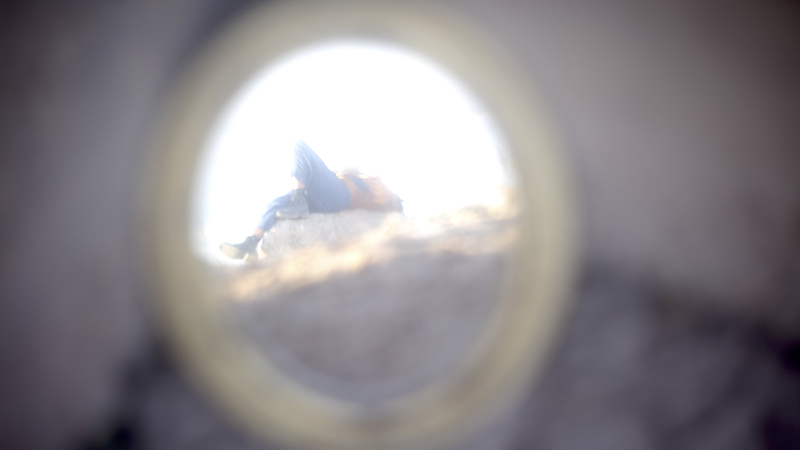
Photo by Monica Kennedy
Nikesha: We each brought our particular energy, and none of us knew what would happen or how it would unfold. It was supposed to be 12 hours, sunrise to sunset, but it ended up being eight hours. I tried to make the costumes versatile to help with keeping cool, keeping warm, being protected, and letting our skin breathe. The day of, we got dressed in our costumes, yawned, and began.
What Miles said about it being a portal was really true. It was like a birth that we were building up to for a long time. Once we entered the performance, I didn’t dance right away. I began with a ritual. I took this ground rock and these little calabash shells, and put a little smidge on every rock up the canyon. I prayed into every rock along the entire path. It became this process of asking permission. Then I realized it wasn’t enough and I needed to give water too. So I went back and gave water to every rock. It was this monotonous simple movement.
Miles was in the same spot doing incremental movement, and I was walking around. It was our first time moving together in-person. We started to feel ways we were communicating between his stillness and my constant movement. With Lazarus’ incredibly responsive sound as he watched us move, we danced to the music, the birds, and the sun.
[Miles had to leave at this point in the interview.]
This past November 2021, you performed Stages of Tectonic Blackness again in Blackdom, NM, a Black homestead town founded in the early 20th century. How did you adapt the piece for that particular site? And what was your experience performing the piece in Blackdom?
Nikesha: We had a second Stages performance at form + concept, a gallery in Santa Fe where I recently exhibited. These following performances weren’t really adaptions so much as iterations.
My family is from Blackdom, so there is a strong historical tie to the land. There was a huge process to even get there, as the land is locked within thousands of acres. We worked in collaboration with New Mexico State University in Las Cruces and 516 Arts in Albuquerque to get access through the state and county. When we were finally able to get onto the land, we had to walk over an hour to even get to the place where we would begin moving. There was this long process that felt like it was part of the dance, pulling carts and walking along dry land.
Blackdom is an archeological site that hasn’t been touched for almost 100 years, which is something to think about: How are we interfacing with this space, preserving it, and returning to it? What does it feel like to have Black bodies moving on the land after 100 years? How does it feel to be those bodies?
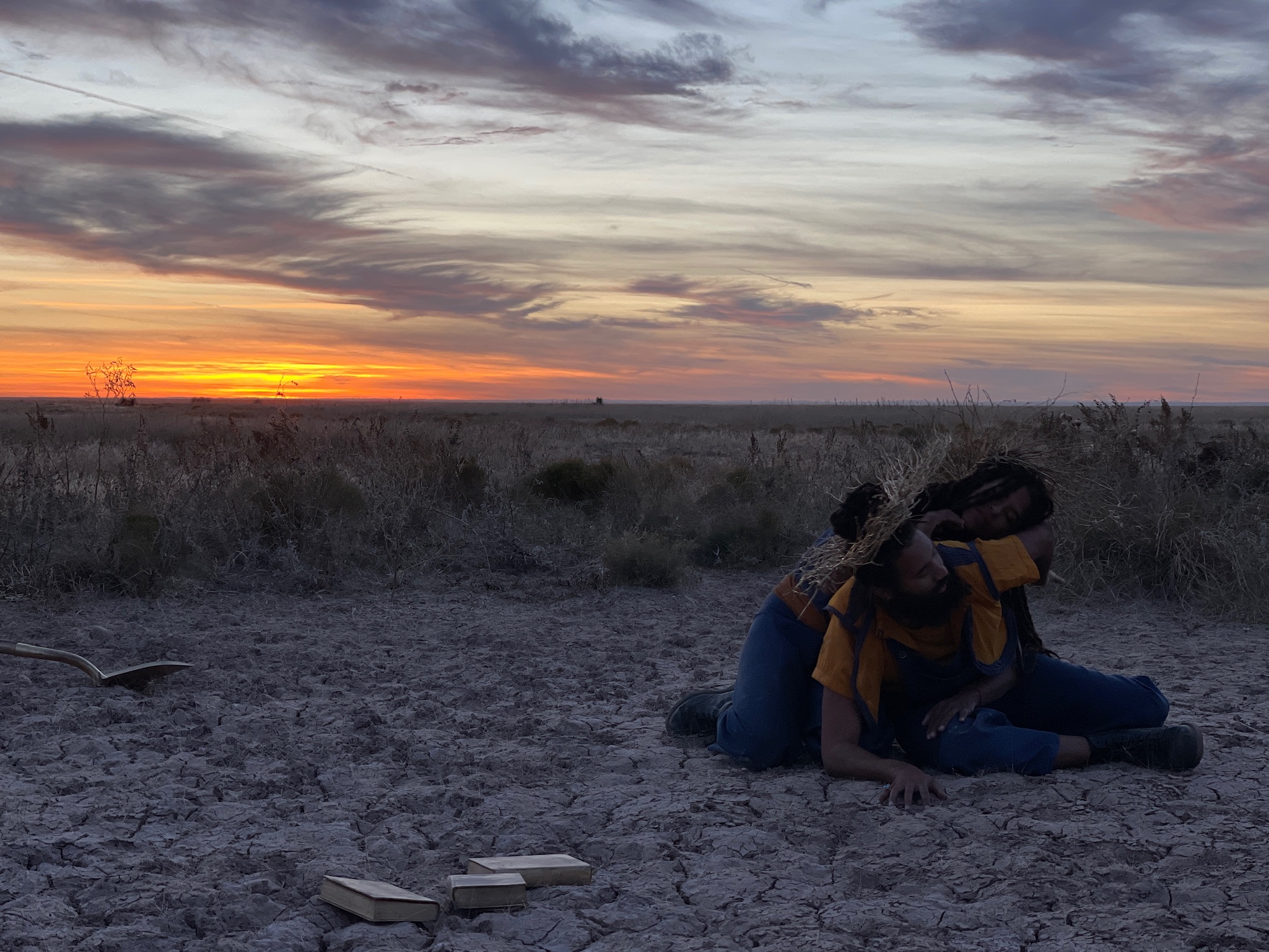
Photo by Noël Hutton
The movement was different. We had to deal with incredible winds, freezing cold in the morning, pitch black when we were coming and leaving. We were there for eight to 12 hours, but we were taking breaks. It wasn’t a public performance. A part of me wishes we had danced longer and not taken as many breaks. I liked in previous performances when I forgot everything existed except the earth and myself.
MK: I would agree, it was a little more fast paced. The first Stages was slower. I had time to navigate. In Blackdom, it was a heavier space and it took time for us to get in the zone. We needed breaks, but I also wanted to keep going. From seeing the footage, the documentation is softer than what we did in the first Stages.
I understand Stages of Tectonic Blackness is being turned into a film. Will the film incorporate the recent performance in Blackdom or only include the Piedra Lisa performance? What are the plans for the film?
Nikesha: The first performance was already turned into a 24-minute single channel film that was shown at my form + concept show in Santa Fe. It has also been shown in Brooklyn at A.I.R. Gallery and is being shown currently at Ogden Contemporary Arts in Utah.
Our performance in Blackdom will be a dual channel video installation, probably around the same length as the first film. In the end, we will create a film library of these different performances, because we also have the video from the performance at form + concept. Each performance has its own research, soundscape, and image texture.
What do you hope audiences take away from watching Stages of Tectonic Blackness, either live or on film?
MK: I’m from Alabama, a different geographic area where Blackness and its history are prominent. When we were preparing for Blackdom, everyone was like, “What’s Blackdom?” It was this place that couldn’t survive. By attempting to make this film, we’re opening that history for people to know more about it. If you Google “Blackdom,” not a lot comes up. Art, performance, and film don’t answer every question, but they give people room to ask more questions and invest in those histories, especially here in New Mexico. I’m wondering what can happen if we activate those spaces more.
Nikesha: Each iteration is different. At Piedra Lisa, having Black folks come and sit on rocks with us was profound. Feeling a Black body move slow is a radical thing. Our culture and society don’t allow for that. It’s an anomaly to see or be a Black body at rest. The Piedra Lisa performance was about that.
Blackdom wasn’t public, so the film will be the main thing that brings it to people. Like MK said, it is so important to claim that history. People don’t know about the history of Black people in the Southwest region, but that history is important. Also, the repercussions of getting the permitting and getting the state involved brought about attention that it’s an important place for African American history. How many ruins are there in this country for African American people that have been erased off the map? There are ruins and archeological finds that should be preserved. The fact we’ve done that work in Blackdom opens the potential for real historical reclamation to happen, like an easement or a memorial site. I would like for audiences to take away that dance and immersive performance can have greater impact beyond the acts themselves. Art is for social change.
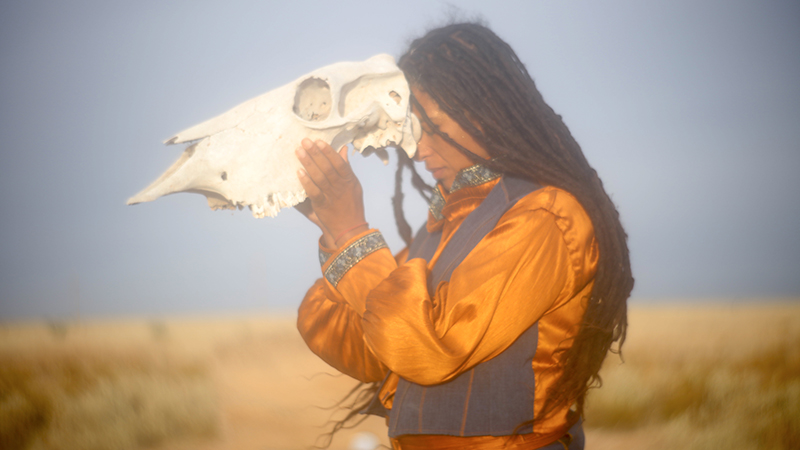
Photo by Monica Kennedy
Do you have intentions of performing Stages of Tectonic Blackness again or expanding it in other directions?
Nikesha: The vision is to take the piece to different points along the African diaspora. I just placed the seed to perform it in an African maroon village on an island in Oaxaca, Mexico. We’re still in the dreaming stages. Every place we’ve gone has been a profound portal. We’ve talked about performing the piece on the East Coast at slave ports or freedom towns. Or the slave castles in Ghana along the Gold Coast, or the Dutch shipyards. We’ve talked about the whole Atlantic slave trade down through South America and finding these points of significant African diasporic history.
MK: It’s work that goes past all our lives. We won’t finish this work. The history of Black people is so rich. There’s so much more to do.
~~
To learn more, visit nikeshabreeze.com/stages-of-tectonic-blackness or www.groundseries.org/stages-of-tectonic-blackness.
All images are from Stages of Tectonic Blackness: Blackdom (Live Performance November 2021)
